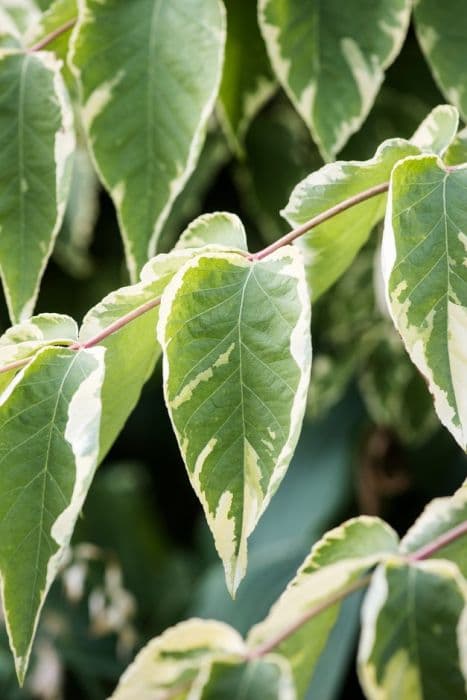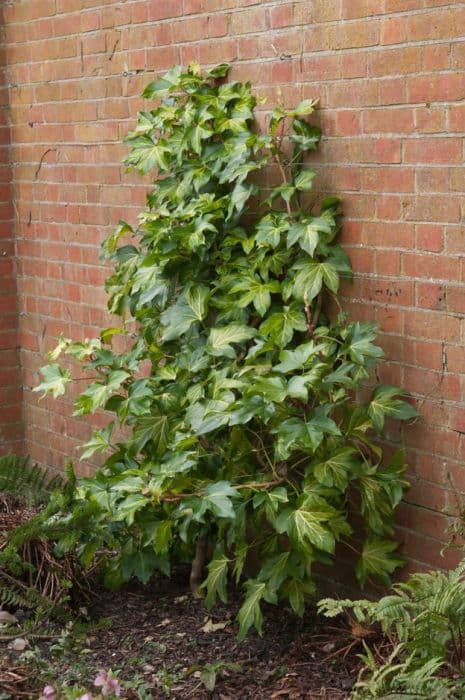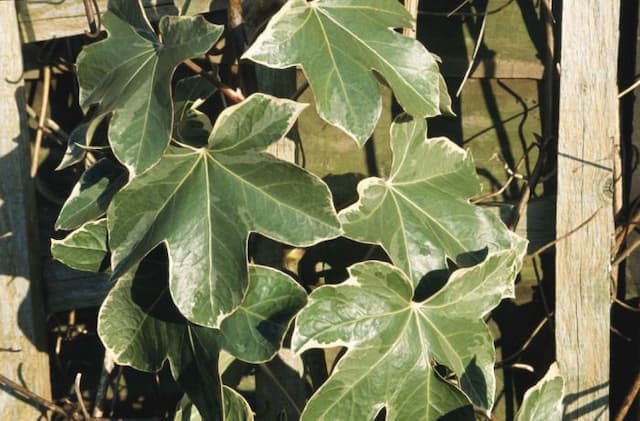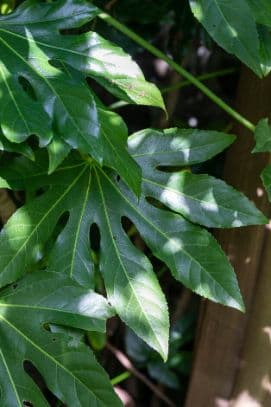English Ivy Hedera helix 'White Knight' (v)

ABOUT
English ivy 'White Knight' is a climbing and trailing vine known for its visually striking foliage. The leaves appear heart-shaped or three-pointed, with a noticeable variation in variegation. They are typically edged with a creamy-white or silver color, wrapping around the edges and streaking into the dark green center. This variegation offers a vibrant contrast that stands out against the deep green hues of the main leaf surface. The leaves are glossy, creating a shimmering effect when light touches their surface. In certain conditions, the English ivy 'White Knight' may produce small, inconspicuous flowers, though it is primarily grown for its decorative foliage. The vine is adept at clinging to surfaces using its aerial rootlets, which enable it to grow across vertical structures or as ground cover, showcasing its ornamental leaves throughout its spread.
About this plant
 Names
NamesFamily
Araliaceae.
Synonyms
Variegated English Ivy, White Knight Ivy, Ivy 'White Knight'.
Common names
Hedera helix 'White Knight'.
 Toxicity
ToxicityTo humans
The common name for Hedera helix 'White Knight' is English ivy. English ivy is considered mildly to moderately toxic to humans if ingested. The plant contains compounds like triterpenoid saponins that can cause gastrointestinal upset, including symptoms such as vomiting, diarrhea, and abdominal pain. In some cases, ingestion can also result in a hypersalivation. Additionally, the sap of the plant contains falcarinol and didehydrofalcarinol which can cause dermatitis upon contact with the skin. It is important to avoid ingesting any part of this plant, and if ingestion occurs, seek medical attention.
To pets
English ivy is toxic to pets. The plant contains triterpenoid saponins that can cause vomiting, abdominal pain, hypersalivation, and diarrhea if ingested. In some cases, ingestion can lead to more severe symptoms including tremors, ataxia, or even coma. It is important to prevent pets from ingesting any part of English ivy, and if ingestion occurs, contact a veterinarian immediately.
 Characteristics
CharacteristicsLife cycle
Perennials
Foliage type
Evergreen
Color of leaves
Variegated
Height
6-8 feet (1.8-2.4 meters)
Spread
1-3 feet (0.3-0.9 meters)
Plant type
Climber
Hardiness zones
5-9
Native area
Europe
Benefits
 General Benefits
General Benefits- Ornamental Appeal: The variegated leaves of the English Ivy 'White Knight' offer aesthetic value to gardens, walls, and indoor spaces.
- Wall and Fence Cover: It can quickly climb and cover walls and fences, providing a green façade and enhancing landscape design.
- Energy Conservation: By covering exterior walls, it provides an additional insulating layer that can help in reducing heating and cooling costs.
- Habitat for Wildlife: The plant provides shelter and food for birds and insects, hence supporting biodiversity.
- Soil Erosion Control: It helps in preventing soil erosion by stabilizing soil with its root system.
 Medical Properties
Medical Properties- This plant is not used for medical purposes.
 Air-purifying Qualities
Air-purifying QualitiesThis plant is not specifically known for air purifying qualities.
 Other Uses
Other Uses- Topiary Art: English ivy 'White Knight' can be trained to grow over wireframes to create living sculptures in gardens and landscapes, offering a unique aesthetic appeal.
- Natural Fabric Dye: The leaves of English ivy can be used to produce a range of natural green dyes for coloring fabrics and yarns in textile production.
- Sound Barrier: Planting English ivy along fences or walls can help reduce noise pollution as its dense growth can act as a sound dampening barrier.
- Erosion Control: The robust and fast-growing characteristics of English ivy make it useful for controlling soil erosion on slopes and banks.
- Craft Material: The vines of English ivy can be dried and used in creating natural wreaths, baskets, and other craft items.
- Privacy Screens: When grown on trellises or fences, English ivy can provide dense coverage that ensures privacy in outdoor living spaces.
- Photo Backdrop: The lush foliage of English ivy can serve as a verdant backdrop for outdoor photography, adding vibrancy and texture to images.
- Theater and Film: English ivy is often used in set design for theater productions and films to create realistic outdoor scenes or enchanted gardens.
- Seasonal Decoration: The variegated leaves of the 'White Knight' variety can provide an interesting and decorative element for seasonal decorations, particularly in fall and winter displays.
- Living Wall Art: English ivy can be used to create living wall art installations, both indoors and outdoors, for a dynamic and eco-friendly decor element.
Interesting Facts
 Feng Shui
Feng ShuiThe English Ivy is not used in Feng Shui practice.
 Zodiac Sign Compitability
Zodiac Sign CompitabilityThe English Ivy is not used in astrology practice.
 Plant Symbolism
Plant Symbolism- Fidelity: As an evergreen plant with the ability to cling tightly to surfaces, Hedera helix, commonly known as English Ivy, symbolizes lasting affection and eternal bonds.
- Protection: English Ivy has been thought to offer protection, as it forms a thick, sheltering cover over walls and trees.
- Friendship: Its interwoven growth patterns represent strong, intertwined relationships, making the plant an emblem of friendship.
- Survival: With its hardy nature and perseverance in various conditions, English Ivy signifies resilience and the will to survive.
- Memory and remembrance: Because it remains green all year round, the plant is frequently associated with memory and remembrance.
 Water
WaterEnglish Ivy 'White Knight' should be watered thoroughly, allowing the soil to dry out slightly between waterings. Generally, it requires watering once every 7 to 10 days, but this can vary depending on the environmental conditions, such as temperature and humidity. When watering, use enough water to ensure that it seeps through the drainage holes, indicating the root system has received adequate moisture. Aim to use about 1 gallon of water for adult plants to achieve this, adjusting the amount as necessary for smaller or larger plants. Avoid letting the plant sit in water, as this can lead to root rot.
 Light
LightEnglish Ivy 'White Knight' thrives in bright, indirect light. It can also adapt to medium light conditions. The best spot for this plant is near a window with a sheer curtain to diffuse direct sunlight, as too much direct sun can scorch the leaves. However, this ivy can also tolerate lower light situations, which makes it versatile for various indoor settings.
 Temperature
TemperatureEnglish Ivy 'White Knight' prefers a temperature range between 50 and 70 degrees Fahrenheit for optimal growth. It can withstand temperatures as low as 10 degrees Fahrenheit, but frost or prolonged exposure to cold will damage the plant. The ideal spot would maintain a consistent temperature away from cold drafts and sudden temperature changes which can stress the plant.
 Pruning
PruningPruning English Ivy 'White Knight' helps maintain its shape, encourage bushier growth, and remove any unhealthy or damaged leaves. Prune as needed throughout the year, focusing on trimming back the longer tendrils and cutting back any dead or yellowing foliage. The best time to do major pruning is in the spring, just before new growth starts.
 Cleaning
CleaningAs needed
 Soil
SoilEnglish Ivy 'White Knight' thrives in well-draining potting soil with a pH range of 5.5 to 6.5. A mix of one part peat, one part pine bark, and one part perlite or coarse sand is ideal. This ensures good aeration and moisture retention.
 Repotting
RepottingEnglish Ivy 'White Knight' should be repotted every two to three years, or when it becomes root-bound. Spring is the best time to repot to minimize stress and promote healthy growth.
 Humidity & Misting
Humidity & MistingEnglish Ivy 'White Knight' prefers humidity levels of 40-50%. It thrives if the air is somewhat moist, which can be maintained with regular misting or a humidifier in dry climates.
 Suitable locations
Suitable locationsIndoor
For indoor care, place English Ivy 'White Knight' in bright, indirect light and ensure high humidity.
Outdoor
Plant English Ivy 'White Knight' in partial to full shade, and shelter from harsh sun.
Hardiness zone
5-11 USDA
 Life cycle
Life cycleThe English Ivy 'White Knight' begins its life with the germination of the seed, usually in spring, in a moist and shaded environment. After germination, seedlings establish themselves with juvenile foliage, characterized by lobed leaves and a creeping growth habit. As the plant matures, it will develop adventitious roots that allow it to climb and adhere to surfaces. During its climbing stage, which can last many years, the ivy will produce broad, unlobed adult leaves and, if conditions allow, eventually reach reproductive maturity. Once mature, it produces small, inconspicuous flowers in the late summer to fall, which are followed by dark berries. The plant can then enter a period of dormancy in winter, particularly in cooler climates, before resuming growth in the spring.
 Propogation
PropogationPropogation time
Spring-Early Summer
Propogation: The English Ivy 'White Knight', being a cultivar of Hedera helix, can be propagated most effectively through stem cuttings. This popular method typically takes place in the spring or early summer when the plant's growth is most vigorous. To propagate by stem cuttings, one would cut a 4 to 6 inch (approximately 10 to 15 cm) length of stem from a healthy plant, making sure that each cutting has at least one set of leaves. The lower leaves are then removed, and the cut end of the stem may be dipped in rooting hormone to encourage root development. Afterwards, the cutting is placed in moist soil or a water container, ensuring that the leaf nodes are in contact with the soil or water, and kept in indirect light. Within a few weeks, roots will develop, and the new plants can be transplanted to their permanent locations once they've established a strong root system.









